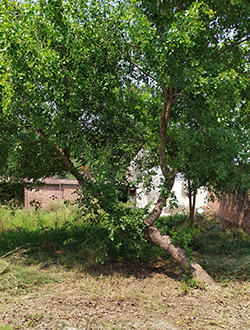Dalbergia Sissoo Root Problems and Treatment Options
Dalbergia Sissoo Root Problems and Treatment Options
Sissoo roots and shoots running amuck in your yard? They are in many of our listeners' yards. We regularly receive calls for tips to control or get rid them. They can be hard to control, but they can be contained.
John Eisenhower, ISA Certified Arborist, Integrity SavATree a Rosie-Certified Partner, explains that the Dalbergia sissoo (Indian Rosewood) is a vigorous tree known to send up sprouts long distances from the parent tree. Although Dalbergia sissoo is not listed as an invasive species, it is considered by many horticulturists to be a nuisance tree because of its aggressive rooting and sprouting.

Root encroachment is another common problem with Dalbergia sissoo. Roots can threaten sidewalks, pavers, curbing, block walls and other landscape elements including lawns. The sprouts that spontaneously emerge from Dalbergia roots can also destroy the beauty and functionality of surrounding landscaping. These satellite sprouts not only grow in unwanted areas; they also can grow to become new trees.
Treatment Options
Remedial treatments to control root encroachment and sprouting include chemical applications of herbicides, the use of physical root barriers and, finally, soil removal and replacement.
Tree Removal
If you decide to remove a Dalbergia sissoo tree because of aggressive roots or Sprouting, follow these steps:
- Remove Tree: Start by removing the tree and cutting the stump as close to soil grade as possible.
- Drill Holes into Stump: Immediately after cutting down the tree, drill as many 3/4" diameter holes as possible into the outside edge of the stump. Holes should be 4 to 6-inches deep and spaced 2 to 3-inches apart. Avoid drilling in the inner heartwood area on the top of the stump because this is less conductive tissue. Drill holes in the outer sapwood ring on the top of the stump, angling the holes toward any obvious root flares. Also avoid drilling too deep and into the soil. If this happens, do not apply herbicide in these holes.
- Apply Systemic Herbicide: Pour or inject a systemic herbicide into the drilled holes in the stump. Contact herbicides work by absorption into a plant's vascular system. The active chemicals placed into the stump holes are transported to the roots and also to the sprouts they produce. This type of systemic treatment of the stump is the most effective means of controlling satellite sprouts.
- IMPORTANT NOTE: Once the stump is dug or ground out, there is no way to systemically reach the roots and satellite sprouts again.
- WARNING: Some chemicals must be applied only by a State-licensed spray applicator. For more information about spray licensing and regulations in Arizona, contact: http://www.sb.state.az.us
- Remove Stump: Wait 30-45 days to allow full absorption of the herbicide into the root system before removing the stump. Evidence of successful absorption will be the dieback and death of stump sprouts and nearby satellite sprouts. Commonly there is effective sprout control to a radius of 10 to 12 feet from the stump.
- Spot Treat Sprouts: Some roots and sprouts that grow too far from the tree to be effected by the chemical stump treatment, need to be spot treated. Dig down around the sprouts, then chase and expose as many roots as possible. Don't cut or pull up the sprouts. The larger the treatable surface, the more effective the chemical absorption. Apply the systemic herbicide directly onto the sprouts and exposed root surfaces. Persistent treatment over several months may be needed for full control.
Root Barrier Installation:
Another option for controlling root encroachment is to install a root barrier. A root barrier is a shield of durable material designed to deflect roots away from a protected object or area. Barriers can be any length and are normally placed in a trench at a specific depth depending on tree species and root location. Soil Replacement: A final remedy for root invasion is complete soil removal and replacement. This requires manual or mechanical removal of all the soil within the root zone of a tree to the full depth of the deepest roots. Once the soil and all root material is removed, new replacement soil can be installed.
Written By: John Eisenhower of Integrity SavATree
###
Photo Credits:
- Shutterstock
RELATED CONTENT:
- Bog: Plants: Out of Control
- Blog: The Toughest Stuff to Grow in Arizona
- DIY Q&A: Tips for setting up your drip irrigation system
- Shade trees: 5 great, low-water shade trees for your home
- Search our DIY Home Improvement Database & Library
- Podcast: Winter Warmth & Indoor Heating
- Podcast: 10 Facts You Need To Know About Water Damage
